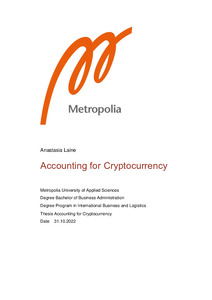Accounting for Cryptocurrencies
Laine, Anastasia (2022)
Laine, Anastasia
2022
All rights reserved. This publication is copyrighted. You may download, display and print it for Your own personal use. Commercial use is prohibited.
Julkaisun pysyvä osoite on
https://urn.fi/URN:NBN:fi:amk-2022111422664
https://urn.fi/URN:NBN:fi:amk-2022111422664
Tiivistelmä
The idea of peer-to-peer electronic cash was introduced in a whitepaper by the pseudonym Satoshi Nakamoto in 2008. The primary objective was not to create a completely new currency but to establish a decentralized payment system for different parties without a financial institution. What started as Bitcoin, grew into a nearly 2 trillion USD investment industry available to retail investors, organizations, and institutional investors.
Currently, there is no unified accounting and classification framework for cryptocurrencies and other cryptographic assets. Consequently, there is no generally accepted definition for crypto assets. Hence, the primary objective of this study is to identify the appropriate financial reporting framework and determine the risks stakeholders and investors face from unharmonized accounting and classification treatment.
As a result of a comprehensive overview of the existing financial reporting standards it appears that theoretically, cryptocurrencies and other cryptographic assets fall under the definition of ‘Intangible Assets’ of both GAAP and IFRS standards. However, in practice financial reporting is judgmental. Therefore, a standalone standard implementation seems to be appropriate. Although it is an expensive and time-consuming process, it still appears to be the only solution to solve investor protection, classification confusion, taxation, monetary policy, financial system stability, and money laundry risks.
Currently, there is no unified accounting and classification framework for cryptocurrencies and other cryptographic assets. Consequently, there is no generally accepted definition for crypto assets. Hence, the primary objective of this study is to identify the appropriate financial reporting framework and determine the risks stakeholders and investors face from unharmonized accounting and classification treatment.
As a result of a comprehensive overview of the existing financial reporting standards it appears that theoretically, cryptocurrencies and other cryptographic assets fall under the definition of ‘Intangible Assets’ of both GAAP and IFRS standards. However, in practice financial reporting is judgmental. Therefore, a standalone standard implementation seems to be appropriate. Although it is an expensive and time-consuming process, it still appears to be the only solution to solve investor protection, classification confusion, taxation, monetary policy, financial system stability, and money laundry risks.
